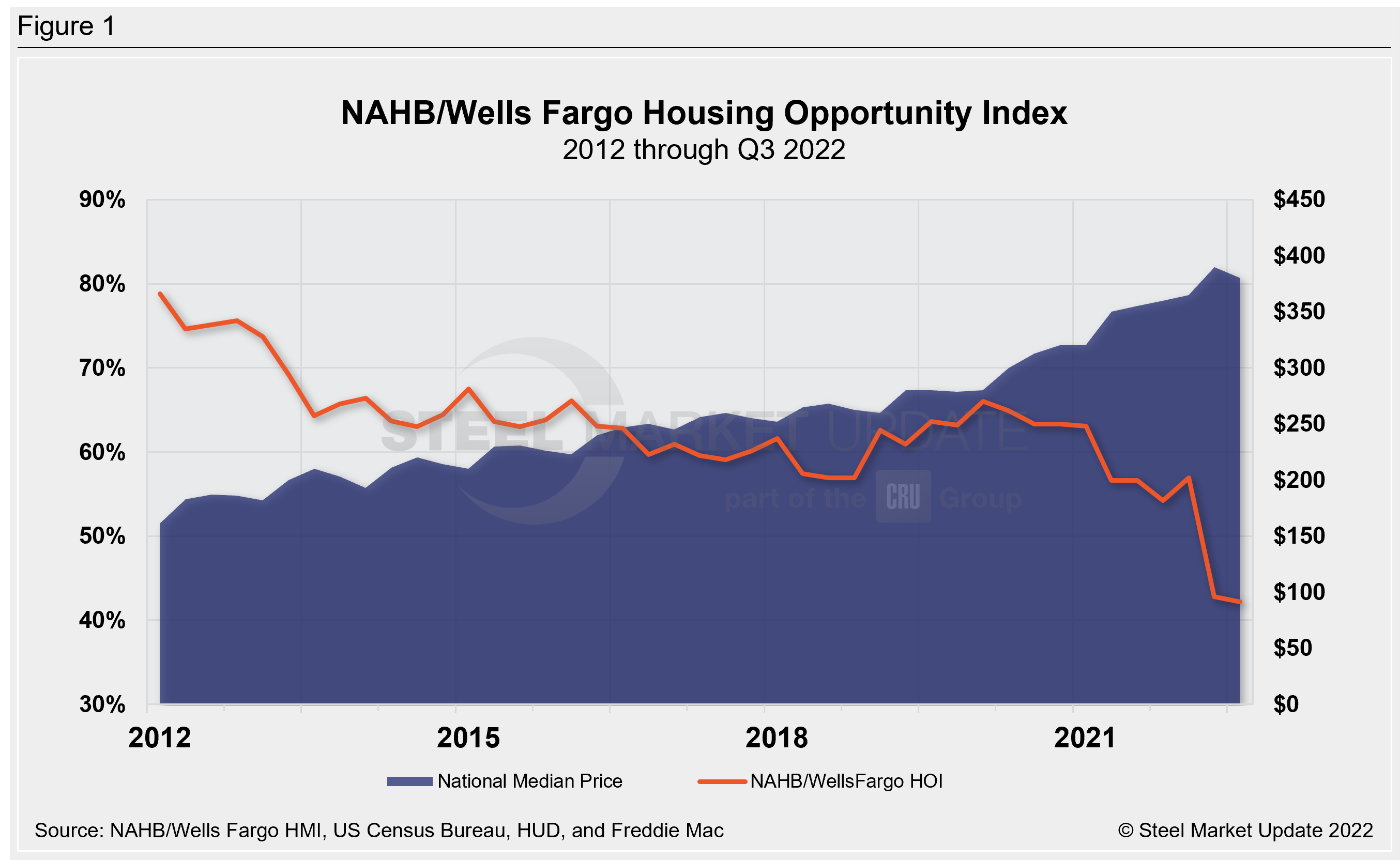Steel Markets

Costs Push Housing Affordability to 10-Year Low: NAHB
Written by David Schollaert
November 13, 2022
Housing costs continue to rise in the third quarter. New homes are now more expensive than they’ve been in more than a decade, the National Association of Home Builders (NAHB) said.
The result: the housing market has tipped into a recession. The trend has been driven by rising mortgage rates, ongoing building material supply chain disruptions, high inflation, and high home prices, NAHB said.
The situation is expected to worsen through the end of the year because mortgage rates continued to rise in the fall, the group said.
Just 42.2% of new and existing homes sold between the beginning of July and the end of September were affordable to families earning the US median income of $90,000, according to the NAHB/Wells Fargo Housing Opportunity Index (HOI).
“The housing market and affordability conditions have continued to weaken throughout the year as rising mortgage rates, supply chain bottlenecks, and a lack of skilled construction workers continue to push housing costs higher,” NAHB chairman Jerry Konter said. Konter is also a home builder and developer in Savannah, Ga. “Entry-level buyers are particularly hurt, as more of them are getting priced out of the market.”
The national median home price fell to $380,000 in Q3, down 2.6% from a record high of $390,000 in Q2. Meanwhile, average mortgage rates rose from 5.33% in Q2 to a series high of 5.72% in Q3.
The average commitment rate for a 30-year, conventional, fixed-rate mortgage surpassed 7% in October for the first time since April 2002, up from 6.11% the month prior, according to Freddie Mac.

“Builder sentiment has declined ten straight months, and worsening affordability conditions remain a top concern as single-family production continues to decline and buyers pull back because of rising interest rates,” said NAHB chief economist Robert Dietz. “The best way to reduce housing costs is to boost supply. Policymakers must prioritize fixing building material supply chains and easing excessive regulations to help bring down construction costs and enable home builders to increase housing production.”
Lansing-East Lansing, Mich., was the nation’s most affordable major housing market. More than 84% of all new and existing homes sold in Q3 were affordable to families earning the area’s median income, the report said. Indianapolis-Carmel-Anderson, Ind., Scranton-Wilkes-Barre, Pa., Toledo, Ohio, and Syracuse, N.Y., rounded out the top five most affordable major US housing markets.
Meanwhile, Cumberland, Md.-W.Va., was rated the nation’s most affordable small market, with more than 92% of homes sold in Q3 affordable to median-income families. That area was followed by Wheeling, W.Va.-Ohio, Davenport-Moline-Rock Island, Iowa-Ill., Elmira, N.Y., and Utica-Rome, N.Y.
In Q3 just 3.7% of the homes sold in Los Angeles-Long Beach-Glendale, Calif., were affordable to the area’s median-income households. That region has been the nation’s least affordable major housing market for eight straight quarters. Anaheim-Santa Ana-Irvine, San Diego-Chula Vista-Carlsbad, Oxnard-Thousand-Oaks-Ventura, San Francisco-San Mateo-Redwood City, Calif., rounded out the top five most expensive major US housing markets.
The top five least affordable small housing markets were also in the Golden State, the report said.
By David Schollaert, David@SteelMarketUpdate.com

David Schollaert
Read more from David SchollaertLatest in Steel Markets

CMC looks beyond Arizona micro-mill woes to long-term viability of construction mart
Despite the economic and geopolitical upheaval of the last five years, CMC President and CEO Peter Matt points out that the construction market has been an essential element of the way forward.

US importers face stricter rules under revamped S232 tariffs
“CBP expects full compliance from the trade community for accurate reporting and payment of the additional duties. CBP will take enforcement action on non-compliance," the agency said in a March 7 bulletin.

Steel exports rebound in January
US steel exports recovered to a five-month high in January after having fallen to a two-year low in December. This growth follows four consecutive months of declining exports.

Construction spending drops marginally in January
Construction spending edged down slightly in January, slipping for the first time in four months. The US Census Bureau estimated spending at a seasonally adjusted annual rate of $2,196 billion in January, down 0.2% from December’s downward revised rate. The January figure is 3.3% higher than a year ago. January’s result, despite the slight erosion, […]

HVAC equipment shipments slow in December but strong annually
Shipments of heating and cooling equipment in the US fell to an 11-month low in December, according to the latest data released by the Air-Conditioning, Heating, and Refrigeration Institute (AHRI).
